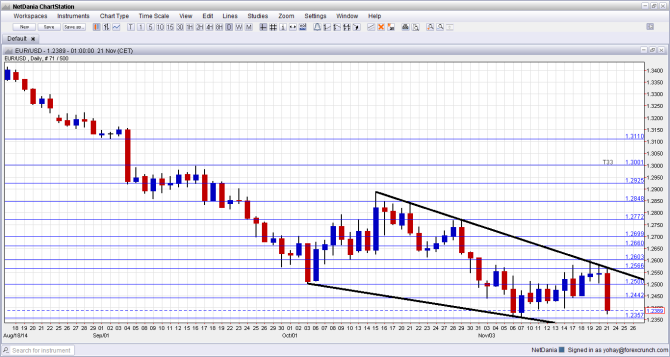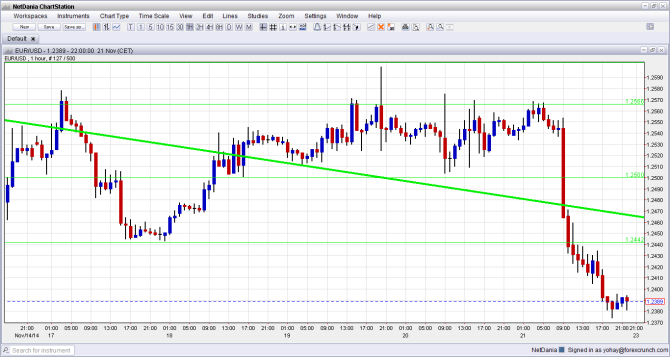EUR/USD traded in range for some time, but eventually lost ground and closed under 1.24. Can it extend its falls?The main events this week are the preliminary inflation releases, employment data as well as another German business survey. Here is an outlook on the highlights of this week and an updated technical analysis for EUR/USD.
After long months of falls, Germany’s ZEW business confidence finally bounced back as investors returned to optimism. However, fresh purchasing managers’ indices disappointed. Germany’s flat manufacturing PMI was especially worrying. The final blow came from ECB president Draghi: he not only hinted about QE, but showed determination to act fast on battling the specter of deflation. This second speech of his was not challenged by the Germans, and the euro was hit hard. In the US, the FOMC meeting minutes revealed that the Fed is somewhat worried about inflation expectations and widely agreed on leaving the “considerable time” phrase regarding rates. However, the global slowdown has little impact on the US according to the officials, Encouraging data from inflation, home sales and manufacturing did little to help the greenback.
[do action=”autoupdate” tag=”EURUSDUpdate”/]EUR/USD daily chart with support and resistance lines on it. Click to enlarge:
- German Ifo Business Climate: Monday, 9:00. IFO is Germany’s No. 1 Think Tank, and its 7000 strong business survey carries a lot of weight despite being published after the ZEW one. In recent months, business climate has been deteriorating according to IFO, with a recent fall to 103.2 points in October. After we have seen a bounce up from ZEW, a minor drop is expected here: 103 points.
- Belgian NBB Business Climate: Monday, 14:00. While this comes from a small country, the wide survey is highly regarded. The indicator bounced back up in October, to -6.8 points, but the negative number still means deteriorating conditions. A small improvement is predicted now: -5.3 points.
- German Final GDP: Tuesday, 7:00. According to the preliminary release, Germany managed to escape a recession and print a growth rate of 0.1% in Q3. This will likely be confirmed in the final read. However, a small slip to 0% would certainly be worrying.
- German Import Prices: Wednesday, 7:00. Prices of imported goods serve as another measure of inflation. Given the slide in the price of oil and the relative stability of the euro in October, a slide of 0.3% is expected, after a rise of 0.3% in September.
- German CPI: Thursday, states report during the morning, final all-German figure at 13:00. Germany saw prices fall by 0.3% in October, more than anticipated. The y/y HICP (European standard) slipped down to 0.7%. While this is above the euro-zone level of 0.4%, it is far from the ECB’s target. Any slip in y/y inflation will not bode well for the all-European number on Friday. A slide to 0.6% is predicted for the HICP. Month over month, no change is expected.
- Spanish CPI: Thursday, 8:00. The zone’s 4th largest economy is experiencing outright deflation for four consecutive months, but annual price drops have moderated and hit 0.1% in October. This too, provides a hint towards Friday. A y/y drop of 0.3% is on the cards.
- German Unemployment Change: Thursday, 8:55. The euro-zone’s powerhouse surprised with a big drop in unemployment: 22K, and this was certainly encouraging, especially for Chancellor Merkel. A correction cannot be ruled out now, but expectations stand on another minor drop of 1K.
- M3 Money Supply: Thursday, 9:00. The European Central Bank is monitoring the level of month growth as another measure of its transmission of monetary stimulus. Y/y growth surprised to the upside and reached 2.5% in September. A similar number is expected now: 2.6%.
- Private Loans: Thursday, 9:00. On the flip-side, the volume of loans to businesses and consumers is still shrinking year over year, despite the Bank’s efforts to spur money lending. A year over year drop of 1.2% has been recorded in September, and another squeeze in falls is likely now, with an annual fall of 1%.
- German GfK Consumer Climate: Thursday, 12:00. This survey looks at consumers rather than businesses. During 2014, the survey of 2000 consumers has been swinging between 8 to 9 points, hitting 8.5 points in October. A slight rise can be expected now to 8.6 points.
- German Retail Sales: Friday, 7:00. September saw a big drop of 3.2% in retail sales. This is worrying for the euro-area’s locomotive as internal demand is sliding. For the month of October, a rise of 1.7% is expected to follow.
- French Consumer Spending: Friday, 7:45. French consumption has been akin to a see-saw of late, switching between drops and rises in recent months. After a drop of 0.8% in September, a bounce is expected for Europe’s second largest economy: 0.2%.
- CPI: Friday, 10:00. This is the key event leading into next week’s ultimate rate decision for 2014. Year over year price rises stand at only 0.4% in October, too far from the ECB’s 2% “or a bit below” mandate. The fall in oil prices during November together with a stable euro may have led to another slide in prices at the headline level to 0.3%. Core CPI stood on 0.7%, which is somewhat more encouraging. A rise in this number could give the ECB something to cling on to, but the official expectation stands on 0.7%.
- Unemployment Rate: Friday, 10:00. This is the painful spot for Europe: unemployment is still sky high at 11.5% and has stopped falling. Also for the month of October, no change is likely.
* All times are GMT
EUR/USD Technical Analysis
Euro/dollar started off the week with an attempt on the 1.2570 resistance line (mentioned last week), but this initial move failed and the pair returned to range. The big fall came on Friday, when the pair bounced down from downtrend resistance and had the lowest close since 2012.
Live chart of EUR/USD: [do action=”tradingviews” pair=”EURUSD” interval=”60″/]
Technical lines from top to bottom:
1.30 is more than a round number. The pair bounced off this line before making the big fall. The 1.2920 level was the initial low and should be watched as well.
1.2850 worked as support in September and later capped the pair.1.2775 proved to be a stubborn top in October 2014 and is the important resistance line to the upside.
1.27 is a round number and also worked as resistance to a recovery attempt. This is followed by 1.2660 – which marks the beginning of long term uptrend support.
Below, 1.2570 is the initial low seen in October and now a line of resistance. The next line is critical: of 1.25, which is USD/EUR at 0.80. The pair flirted with this line and even dipped below it in October. This is key resistance now.
1.2440 is only a pivotal line within the recent range, and now the round number of 1.24 has established itself as support. It is followed by 1.2360, which worked as support more than once, including in November 2014.
1.2250 served as support several times in that summer, and 1.2170 was the “shoulder” in the inverse H&S pattern around the same time. The last line is the 2012 low of 1.2040.
Even lower, the post crisis low of 1.1875 should be watched, as well as 1.17, which was the launch value of the pair in 1999.
Downtrend resistance
As the thick black line shows, the pair is trading under downtrend resistance since mid October. This line should be watched in recovery attempts.
Here is closer look at recent movements via the hourly chart, which shows nice range trading before the fall:
I am bearish on EUR/USD
After long days of consolidation, monetary policy divergence pushed the pair lower and this probably isn’t over, as the ECB is certainly determined to act decisively. Weak inflation data is set to confirm the urgency of QE. In the US, inflation is going in the other direction and the Fed is on course to tightening. A confirmation of strong growth in the US could give the greenback another boost.
In our latest podcast, we talk about the state of US housing, run down the FOMC minutes, the Japanese jump, the Draghi drama and also talk oil:
Subscribe to our podcast on iTunes.
Further reading:
- For a broad view of all the week’s major events worldwide, read the USD outlook.
- For the Japanese yen, read the USD/JPY forecast.
- For GBP/USD (cable), look into the British Pound forecast.
- For the Australian dollar (Aussie), check out the AUD to USD forecast.
- USD/CAD (loonie), check out the Canadian dollar forecast
- For the kiwi, see the NZDUSD forecast.


